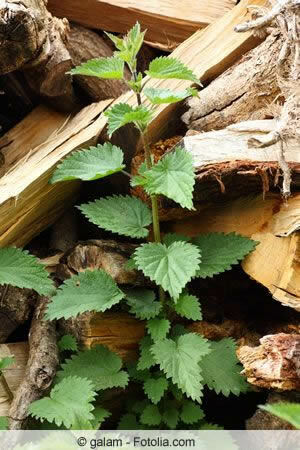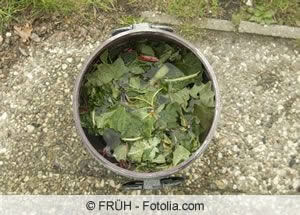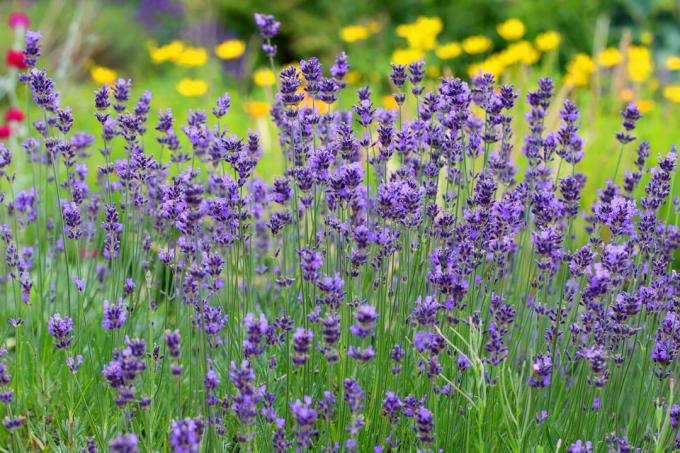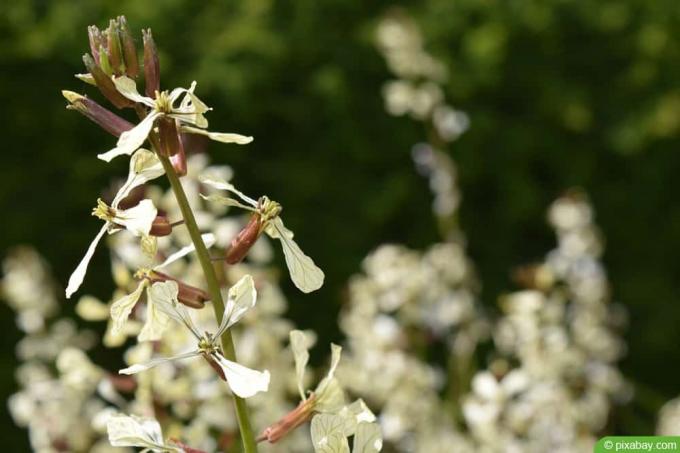

Table of contents
- Great Nettle - Wanted Poster
- Small nettle - profile
- substrate and soil
- plants and harvest
- harvest time and use
- storage and preservation
- Conclusion
The stinging nettle (Urtica dioica) and the small stinging nettle (Urtica urens) are much more than weeds that have no place in the garden. The wide range of applications from the tasty soup on diuretic tea to natural pesticides make the apparent weeds a valuable part of our gardens. Nettles should therefore be harvested and used in multiple ways. Here we give you valuable tips for harvesting and use.
Great Nettle - Wanted Poster
The Great Nettle (Urtica dioica) is a vigorous herbaceous plant. As a protection against herbivores, stinging hairs grow on the leaf stalks, which release siliceous substances when touched, which lead to wheals and itching on human skin.
- Growth heights between 30 cm and more than one and a half meters
- angular stems with opposite leaves
- Flowering time from July to October
- strong root growth, develops impressive hosts
- Flowers develop inconspicuous flower spikes
The nettle seeds develop from the flowers and can be pressed into oil or roasted. The nettle has also been known for a long time for fiber production, which nowadays only takes place occasionally. Nettle fabrics are considered pleasantly soft. They are also suitable for allergy sufferers.
Small nettle - profile
The Little Nettle (Urtica urens) is an annual plant that often appears on rubble heaps, near manure heaps or in vegetable crops.
- Leaves are smaller and more rounded than those of the common nettle
- grows in groups of single plants
- prefers nitrogen-rich soil
- Growth height 10 to 60 cm high
- Stinging hairs burn harder than those of their larger relatives
- reproduces by wind pollination.
The plant can be used whole, young leaf sprouts make a tasty, vitamin-rich salad, infusions from the leaves and roots are considered diuretic. The foliage is used as forage, fertilizer and pest control. Traditionally, finely chopped stinging nettle is a good feed, which is used especially when rearing chicks.
Tip:
Add young nettle leaves to popular vegetable smoothies. You get a fresh, healthy juice that also tastes delicious.
substrate and soil

The stinging nettle grows almost everywhere where the soil is endowed with a lot of nitrogen. Both varieties love the shade rather than the blazing sun, but can cope with almost all lighting conditions. They are often found near unused real estate, i.e. barns, unoccupied houses, piles of rubble or vegetable beds that are heavily fertilized. In our garden, care must be taken to ensure that the hosts of the large stinging nettle do not damage the vegetable plants. The plants are also a popular feeding place for butterfly caterpillars, which can also lead to irritation in the vegetable bed when the caterpillars switch to vegetable plants. If you want to cultivate nettles, watch out for caterpillar infestation. However, they can be easily collected.
The common stinging nettle can be applied directly to the ground as seeds. However, since it reproduces very quickly via its own root growth, planting an existing or shared host is much easier. In order to limit the vigorous growth of the plants, the soil around the plant should be loosened regularly. The excess rhizomes (root shoots) are then also pulled out of the ground, so it remains limited to a certain area.
Tip:
Since the peacock butterfly and the small tortoiseshell feed almost exclusively on stinging nettles and these butterfly species are considered rare, you can simply tolerate a few caterpillars.
plants and harvest
Basically, the nettle plants should not be harvested without gloves. Especially in the small species, contact with the stinging hairs is often accompanied by painful wheals and severe itching.
Large and small nettles can be harvested at almost any time. In spring, the young, tender plants serve as a welcome vegetable for many dishes in the kitchen.
In order to defuse the stinging hairs so that the leaves can be used without regret, it is advisable to first cut off the plants with normal household quantities using long gloves. Then they can be placed in a kitchen towel or towel and simply rolled up with the fabric. A little wringing loosens the last little heads that contain the burning silica. Now the leaves can be safely processed further.
harvest time and use
The foliage is used in cooking for savory dishes and as a tea. We recommend harvesting from early spring, around May, with the very young shoots right through to the flowering period. Flowering nettles no longer taste as good and can easily become fibrous.
Oil can be made from the seeds. Nettle oil is a high-quality vegetable oil that is rarely produced and offered. If you want to produce it yourself, you should only harvest the ripe seeds, i.e. from around October. It has a greenish color and an odor reminiscent of fresh carrots.
The dried nettle straw can be processed into fabrics. Nettle cloth was made from the bast fibers of the nettle thousands of years ago. The harvest time for this is also October, when the plant is fully grown. The long, extremely tough fibers are ideal for making solid fabrics, fishing nets or ropes. Before cotton was used here, nettle cloth and linen (made from flax) were widespread.
The roots are used as a tea. They should only be harvested in the second year of growth, harvest time is late autumn. The roots are dug up, cleaned and cut into small pieces. They can be used dry or fresh.

Large and small nettles are equally welcome as forage plants. It contains a lot of nutrients, minerals and trace elements. For fodder purposes, the plants can be harvested two to three times a year, for example in July and September. They are indispensable as animal feed for rearing animals.
Both nettle species serve as natural pest control agents. A manure made from it can be used anywhere in the garden without any harmful side effects, but especially on vegetable or fruit plants, the harvest of which is eaten. At the same time, the stinging nettle is an excellent fertilizer and can be used as a cold water mixture or liquid manure.
Tip:
Nettle seed is excellent for drying, roasting and grinding. It tastes like sesame and is an excellent addition to the meal.
storage and preservation
Dried nettles can be used all year round. In order to gently dry the plants, they are wrapped in gardener's bast and hung up in a dry, dark place. This can be in the basement or in the garage. The cut roots should be dried in the dark, an airy environment is an advantage. After complete drying, it should be stored in screw-top jars or a linen cloth.
Tip:
The roots are not only recommended as a tea, they are also a good way to strengthen the hair roots in case of hair loss. The infusion also ensures shiny hair.
Conclusion
Stinging nettles, which are often misunderstood and wrongly called weeds, are a true miracle cure of nature. Whether as a remedy, in cosmetics or as an indispensable helper for fertilizing and pest control in the garden, it is always a natural alternative. Plant a shrub of nettles in your garden and you have a multi-purpose weapon for numerous uses. The low risk of injuring yourself on the stinging hairs always outweighs the diverse possibilities of the plants.
The healthy stinging nettle can be very tasty when treated properly
- If you eat them, stinging nettles will convince you with their low calorie content (49 kcal per 100 g), their They also contain a high vitamin C content (175 mg per 100 g) and a great deal of iron (2.2 mg per 100 g). still.
- Fresh and young, still light green nettle leaves taste really delicious: slightly nutty, maybe a bit like flaxseed, fresh and tart and a touch bitter. That alone speaks for the stinging nettle in the garden, when collecting it there are often only dark green leaves, and they taste quite bland, for many people "a little like grass".
- Afraid of nettles when used fresh? It doesn't have to be, they can be deactivated quickly if you briefly dip the nettles in boiling water. If you want to add the stinging nettles to a salad, be sure to soak the stalks in ice water afterwards to keep the leaves green and crisp.
 garden editorial
garden editorial I write about everything that interests me in my garden.
Learn more about garden herbs

Lady's mantle: 9 tips for planting, caring for and cutting
The lady's mantle can be found in almost every garden. There are around 1,000 different species. Here's the best time to plant it and how to care for it. it is also clarified whether and how it has to be cut.

Lavender, Lavandula angustifolia: 14 tips of care
Compared to other lavender varieties, Lavandula angustifolia is hardy down to temperatures of -15°C. In addition, he does not place very high demands on the location. It only needs to be sunny and sheltered from the wind and it loves lean, well-drained and calcareous soil.

Rosemary leaves have white spots: what to do?
Rosemary can be affected by white spots all year round. Before using home remedies, the problem should be investigated. If site conditions and care measures are optimal, diseases and pests can be the cause. Fungi require different control measures than harmful insects.

Rocket is blooming: is it still edible when blooming?
Rocket, also known as rocket, is a traditional cultivated plant that has been somewhat forgotten in recent years. It is now back in fashion and can be found in numerous dishes as a raw vegetable salad, side dish or herb.

Make your own mint tea – What is the effect of fresh mint tea?
Mint tea tastes best when you brew it from freshly picked mint leaves. In this way, the aromatic herb unfolds its healing effect against all kinds of ailments. However, there are also contraindications, because fresh mint tea can also have undesirable side effects.

Harvest peppermint when it blooms? | What to watch out for with mint
Due to its spicy flavor and easy-care properties, peppermint has become widespread in the local latitudes. Only the leaves need to be harvested for consumption. However, there are a number of factors to consider during the flowering period, as the flavor then changes significantly.

